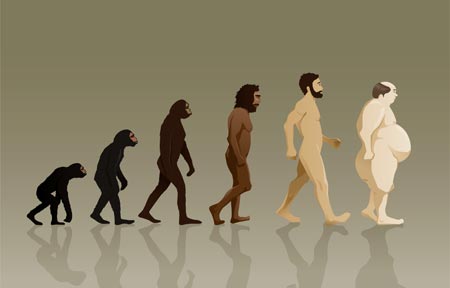
We’ve Become a Sedentary Society
In his book, McAllister points out that humans of today are slower and weaker because they don’t have to use their physical prowess to hunt for food or escape predators. It’s a classic example of “use or lose it,” and it seems humans have lost it over the years as they’ve adopted a more sedentary lifestyle. Most people travel to work by car, sit in a chair most of the day and then return home to relax in front of the television before taking a few steps to their cozy bed where they slumber until morning. According to a study carried out by National Center for Health Statistics, only 30% of Americans exercise regularly and the number isn’t growing fast enough to save them from chronic diseases such as type 2 diabetes, obesity, and heart disease.
The Health Risks of Inactivity
All of that sitting and inactivity has health consequences. A recent study showed that sitting for long periods of time is just as risky as smoking cigarettes, another unhealthy habit that our primitive ancestors didn’t engage in. According to this study, people who sat longer than 6 hours a day had an increased mortality rate compared to those who are more active during the day. The risk of dying prematurely from sitting was greater for women than it was for men.
Why is prolonged sitting such a health risk? Long periods of inactivity cause metabolic changes and a decline in levels of lipoprotein lipase, an enzyme that helps muscle cells take up fats circulating in the blood. When these fats aren’t taken up, they remain in the bloodstream and increase blood triglyceride levels. Inactivity also reduces the ability of muscle cells to take up glucose. This raises circulating glucose levels and increases the risk of insulin resistance. The bottom line is these changes contribute to a person’s risk of type 2 diabetes and heart disease.
Even people who work a sedentary job but head to the gym after work for an hour on the treadmill are at higher risk for death. A workout at the gym doesn’t undo the damage of sitting too much.
Primitive humans didn’t have the luxury of sitting. They were constantly on the move. On the plus side, modern day humans have a longer life expectancy than their ancestors who may not have lived to see the age of thirty. But they died from encounters with predators, not from heart disease, stroke, diabetes and cancer as so many people do today.
The Bottom Line?
We could learn some lessons from our ancestors – the importance of a clean, unprocessed diet and staying active. Instead, we seem to be moving to an even more sedentary society as more technology comes available that allows us to never leave our chair. Enjoy the conveniences of living in modern times, but take a lesson from your ancestors. Eat cleanly and stay as active. Don’t be a softie.
References:
CNN Health.” Study: Most Americans don’t exercise regularly”
Manthropology. Peter McAllister. 2009. Hachette Publishing.
Related Articles By Cathe:
Exercise Around the World: Which Countries Are the Most and Least Physically Active?
Are Cell Phones Making People Less Fit?
“Insignificant” Daily Activities Count for Keeping Weight Off
3 Ways Sitting Less Can Improve Your Work Day and Work Performance
How Sedentary Is the Average Person and How Sedentary Are You?
How Does the Physical Fitness of Kids Today Compare To Kids 20 Years ago?
What Can We Learn From the Slimmest Countries in the World?
Staying a Healthy Weight: 5 Ways French Women Get It Right
Eating for Longevity: What are the Best Eating Practices for Living Longer?

